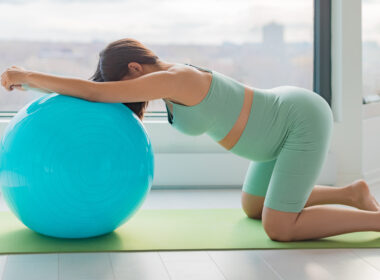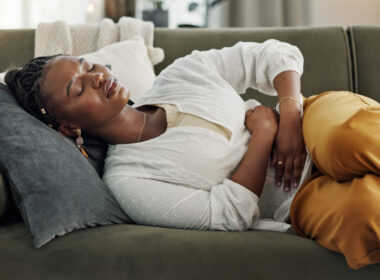You may already suspect that your teen needs more shut-eye each night. But did you know her poor sleep could be making her PMS symptoms worse? While sleep deprivation is a known risk factor for PMS and dysmenorrhea (that is, painful cramping or abdominal pain that can occur before or during your period) in adult women, its effect on adolescent girls is not as widely studied. A 2023 study conducted in Gyeonggi-do, South Korea showed a connection between poor sleep hygiene and increased premenstrual syndrome symptoms in teens [1].
The study investigated whether sleep pattern, duration, and quality affect premenstrual syndrome (PMS) and primary dysmenorrhea in adolescents. Researchers studied 519 South Korean high school girls, aged 15-18, over the course of two months. Results showed that going to bed late (in this case, after 1 am) significantly affected the severity and frequency of PMS symptoms. Getting less than five hours of sleep per night also worsened symptoms, as did getting low-quality sleep (characterized by insomnia and short sleep duration). The most significant connection between sleep and PMS symptoms occurred among girls who got low-quality sleep.
While previous studies on the subject were unreliable because of flawed methods of data collection and vague questioning (i.e. “Do you have dysmenorrhea?”), the South Korean study utilized validated assessment tools.
How is poor sleep connected to PMS symptoms in teens?
In some ways, the connection between PMS (including dysmenorrhea) and sleep deprivation is a “chicken and egg” situation. In other words, it’s unclear if sleep deprivation causes PMS, or if already-existing PMS symptoms make it harder to sleep. Likely, they exacerbate each other, which can lead to a frustrating, vicious cycle of poor sleep hygiene and debilitating premenstrual syndrome each month.
One reason why heightened PMS symptoms could be related to sleep deprivation has to do with melatonin levels. Poor sleep habits such as too much light exposure after the sun goes down (think: screen time too close to bedtime!) and staying up too late at night inhibit the body’s ability to secrete melatonin, which can throw off your circadian rhythm and cause a whole host of sleep problems [2]. Additionally, poor melatonin secretion has also been associated with increased PMS symptoms [3].
It’s also possible that poor sleep could exacerbate premenstrual syndrome by causing inflammation, which is one of the underlying causes of dysmenorrhea [4]. Inflammation is also linked to sleep disturbances, which takes us back to the chicken and egg situation [5].
How can teens improve their sleep hygiene?
The good news is, we have control over our sleep quality–at least to some extent. While we can’t always choose what time we have to be up and at ‘em the morning, and some unlucky individuals are plagued by health conditions that inhibit their ability to get a proper night’s sleep, in most cases we can make a few lifestyle tweaks here and there to make sure we’re getting the most out of each night’s slumber. And we can help our teens do the same.
Teens need more sleep than we think
Perhaps the most basic of these lifestyle changes is making the commitment to go to bed earlier. We’ve all heard that adults should aim for 7-9 hours of sleep per night, but did you know that The American Academy of Sleep Medicine recommends teenagers ages 13-18 get 8-10 hours of sleep per night? Furthermore, they recommend preteens get even more sleep, ideally 9-12 hours per night. With that in mind, it’s worth it to call it a night a little bit earlier.
Could magnesium help?
Check with your healthcare provider about adding a magnesium supplement before bed. This vital mineral can help your muscles relax, promotes an overall sense of calm, and can help you slip into a deeper sleep. And bonus: magnesium also might help reduce PMS symptoms since it helps the body produce and balance hormones, making it a double whammy.
Shut off the (artificial) lights!
Turn down the lights in your home after the sun goes down. Doing so encourages melatonin production and secretion, helping with your circadian rhythm timing and leading to a more restful slumber. Also encourage your teen to avoid scrolling on her phone and watching TV less than an hour before bedtime. Ideally, shoot for 2 hours screen-free before bed. Both may seem like an innocent way to wind down, but the blue light emitted from our screens hurts more than helps us.
Help her prepare for her period
Cycle charting can help your teen know when her period is coming, and prepare accordingly. Knowing that her cycle is a fifth vital sign of health plus how to identify each phase of her cycle (and why she may be feeling the way she is at different times) can help her act mindfully rather than feel like a victim of her biology. And since reducing inflammation can lead to a better night’s sleep, she can emphasize an antioxidant-rich diet, daily exercise, and drinking plenty of water especially in the luteal phase leading up to her period.
Help her say ‘no’ to overcommitment
Between school, studying, extracurriculars, and part time jobs, many teens’ days are jam-packed. We often don’t give them enough time to decompress from all the activity, much less an opportunity to get to bed at a decent hour. In short, our teens’ sleep hygiene doesn’t get a fighting chance–and their hormonal and menstrual health may pay the price.
If your teen is suffering from PMS symptoms and is caught up in a similar loop of busyness, it might be time to have a heart-to-heart and reconsider how much she has on her plate. For the sake of her mental and physical health, it might be time to make some necessary cuts.
The bottom line on PMS symptoms and poor sleep in teens
Did we need a research study to confirm the connection between poor sleep and PMS symptoms, whether for teens or adults? Probably not. But the South Korea study is a good reminder that when and how our teens sleep has real implications for their health. Today (or tonight!) is always a good day (or night!) to start making changes.
Additional Reading:
Fix your sleep, fix your menstrual cycle
How common are PMS and PMDD in teens?
What these teenage girls didn’t know about their cycles
Cycle mindfulness: What happens when you teach teen girls to chart their cycles











